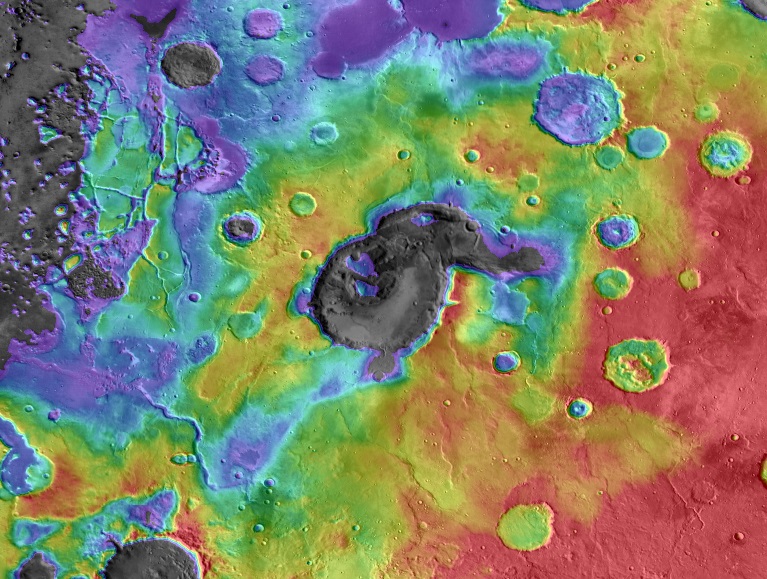







| BOOKS | F. A. Q. | ARTICLES | TALKS | ABOUT KEN | DONATE | BEYOND OUR KEN |
|---|
By Ken Croswell
Published on ScienceNOW (October 2, 2013)

Credit: NASA/JPL/GSFC/Arizona State University
Gigantic volcanic eruptions, far greater than the worst in human history, wracked Mars during its first billion years, say planetary scientists. These "supervolcanoes" spewed enormous quantities of carbon dioxide, water vapor, and sulfur dioxide into the atmosphere, affecting the climate—for good or for ill—at a time when life may have been struggling to arise.
In 1972, NASA's Mariner 9 spacecraft discovered that Mars boasts the solar system's largest volcanoes. Olympus Mons, the greatest, is more than twice as tall as Mount Everest. These mountains are shield volcanoes, so named because they have the shallow slopes of a knight's shield. Immense though they are, the volcanoes are gentle, like the ones in Hawaii, which usually erupt nonviolently. In contrast, the newfound supervolcanoes resemble the one in Yellowstone National Park, which erupted catastrophically 640,000 years ago. On Mars, the supervolcanoes blew themselves up and partially collapsed, so unlike Olympus Mons, they never grew tall and easy to see.
In fact, their discovery was an accident. "I kind of stumbled into it," says planetary geologist Joseph Michalski of the Planetary Science Institute in Tucson, Arizona. He was looking at craters in a region of Mars named Arabia Terra, which has volcanic ash but no known volcanoes. Says Michalski, "I found some craters in Arabia that didn't really look like impact craters, and one of them in particular was obviously a volcano to my eye."
So Michalski contacted volcanologist Jacob Bleacher of NASA's Goddard Space Flight Center in Greenbelt, Maryland. "This might be what old volcanoes look like on Mars," Bleacher says. "They might not have these big, large structures to them like an Olympus Mons." He says the supervolcanoes may solve a long-standing puzzle: "A large amount of the surface is covered by very old volcanic deposits for which we don't know where the vents are."
Writing online today in Nature, Michalski and Bleacher identify seven possible supervolcanoes in northern Arabia Terra. "These were the most explosive volcanoes on Mars," Bleacher says. The best case is one the scientists have named Eden Patera. "That one is definitely a volcano," Michalski says.
Eden Patera—"patera" designates a saucer-shaped object—sports a caldera 1.8 kilometers deep. Fresh impact craters can be deep, too, but they have debris that the impact ejected; Eden Patera doesn't. Furthermore, its caldera, which spans 55 by 85 kilometers, has at least three depressions, suggesting three past eruptions.
"The features they describe do look like volcanic craters to me," says Lionel Wilson, a volcanologist at Lancaster University in England. "This discovery will help to broaden the picture of just what the range of conditions on Mars was."
Says Bleacher, "These eruptions have a very large impact on the climate of a planet and on anything that happens to be living there." Volcanic debris can block sunlight and cool a world, but the supervolcanoes also vented greenhouse gases that likely warmed ancient Mars. Today the Martian atmosphere is so thin that the greenhouse effect raises the temperature only a few degrees. In times past, though, supervolcanic eruptions may have ejected so much carbon dioxide and water vapor that they gave the planet an enhanced greenhouse effect, which led to warmer temperatures. A mild climate would have allowed rivers and lakes to exist, giving life the opportunity to develop on a world 52 percent farther from the Sun than Earth is. Indeed, planetary scientists have long known that some old regions of Mars possess dried-up riverbeds.
Why would Mars host such violent volcanoes? The planet itself may be to blame. Its air is thin, so when magma reaches the surface, gas in the magma expands more explosively than on Earth. Also, the red planet's surface gravity is only 38 percent of Earth's, so Martian magma can ascend faster, giving it less time to lose its gas.
And why Arabia Terra? The crust there is thin, the scientists say, so magma can reach the surface fast, again giving it less of a chance to degas.
Supervolcanoes are so hard to detect that they may lurk elsewhere, too. Says Michalski, "If there are many more examples, which we think there might be, then it's hugely important" for the history of the Martian atmosphere and climate.
Ken Croswell is an astronomer and the author of Magnificent Mars.
"Ken Croswell has done a superb job in outlining what is known, and what is suspected, about the next home of mankind beyond the Moon."--Sir Arthur C. Clarke. See all reviews of Magnificent Mars here.
| BOOKS | F. A. Q. | ARTICLES | TALKS | ABOUT KEN | DONATE | BEYOND OUR KEN |
|---|